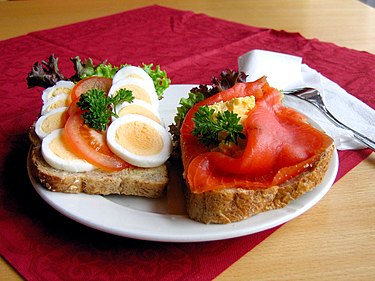Coming to Denmark and Sandy tells me we need to try a Smørbrød, OK but what's the big deal its just an open sandwich!.
So with this dilemma and me trying to figure out what all the fuss is about I Google and Mr Wikipedia has a lot to say on this apparently intriguing subject!
So I've copied and pasted this information to enlighten my blog reader's on this amazing culinary thing know as an
Open Sandwich Ohhh!
Open Sandwich Ohhh!
From Wikipedia, the free encyclopedia

Smørbrød, smørrebrød or smörgås, a Scandinavian open sandwich at a cafeteria in Norway
| |
| Alternative names | Open-face sandwich, open-faced sandwich, tartine, bread baser, bread platter |
|---|---|
| Type | Sandwich |
| Main ingredients | Bread, topping |
| Variations | Many variations exist |
History
A direct precursor to the English sandwich may be found in the Netherlands of the 17th century, where the naturalist John Ray observed that in the taverns beef hung from the rafters "which they cut into thin slices and eat with bread and butter laying the slices upon the butter".[5] These explanatory specifications reveal the Dutch belegd broodje, open-faced sandwich, was as yet unfamiliar in England.
In various countries
Open sandwiches like this are consumed in France, Denmark, Norway, Sweden, Finland, Austria and Germany, the Czech Republic, Hungary, the Netherlands, Poland as well as other parts of Europe, and North America as a regular breakfast and supper food item. The American tongue toast is offered as an entrée for breakfast, lunch, and supper and as an hors d'œuvre for formal parties.
In former Czechoslovakia a popular type of open sandwich is called obložené chlebíčky (pl., sg. obložený chlebíček) - slant ways cut slice of veka (long narrow white bread) spread with butter and/or with various combinations of mayonnaise salads and hard boiled egg, cheese, ham, salami, smoked fish (salmon or sprats or pickled herring), tomato, pickled cucumber, lettuce, raw onion or other vegetable, etc.
Open sandwich is the common, traditional sandwich type in the Nordic countries, Estonia, Latvia, Lithuania, the Netherlands, Russia, Poland, Ukraine, where it is typically eaten at breakfast, lunch, supper, or as a snack. In Finland the sandwich is called voileipä, and in Estonia similarly võileib, which also means "butter bread".
The Scandinavian open sandwich (Danish: smørrebrød, Norwegian: smørbrød, Swedish: smörgås or macka) consists of one piece of buttered bread, often whole-grain rye bread (Danish: rugbrød, Swedish: rågbröd, Finnish: ruisleipä), topped with, for instance, cheese, cold steak, ham, turkey, shrimps, smoked salmon, caviar, hard boiled eggs, bacon, herring, fish fillets, liver pâté (Danish: leverpostej, Norwegian: leverpostei Swedish: leverpastej), and/or small meatballs. This is typically complemented by some herbs and vegetables such as parsley, cold salad, thinly sliced cucumber, tomato wedges and/or pickled beets etc. on the same slice of bread.
A condiment, such as mayonnaise, or mayonnaise-based dressing is also often included in some form. An old traditional replacement for butter on a piece of bread with herring is pig fat. There are many variations associated with the smørrebrød/smørbrød/smörgås and there are even special stores, cafés and restaurants (especially in Denmark) that specialize in them.
The Dutch and Flemish Uitsmijter consists of one or more slices of bread topped with fried eggs (one per slice of bread), and can be accompanied by slices of cheese and/or meat (roast beef or ham). The dish is often served as a hearty breakfast. Sweet toppings are commonly used for breakfast in the Netherlands and Belgium: e.g. sprinkles, vlokken, or muisjes, next to the more widespread peanut butter, honey, jam, and chocolate spread.
In Great Britain, open sandwiches are rare outside of Scandinavian delicatessens. Instead, there is "on toast" (e.g., cheese on toast). However, this is not considered a sandwich. The open sandwiches found in Great Britain are the Welsh rarebit and the Scotch woodcock, an open sandwich served historically at the colleges of the University of Cambridge and University of Oxford and in the refreshment rooms of the House of Commons of the United Kingdom as late as 1949.
In North America an open faced sandwich may also refer to a slice of bread topped with warm slices of roasted meat and gravy. Examples include a beef Manhattan, a hot chicken sandwich in Canada, or Welsh rarebit. This is also done in Scandinavian countries, where they also eat open faced sandwiches with fried meat and fried fish.
So apparently we need to hit the streets of Copenhagen and do our own research ... really do we have too ... I will report back later if it turns out to be some sort of amazing gastronomic experience!!!!!





No comments:
Post a Comment